Smile Gallery
Bonding
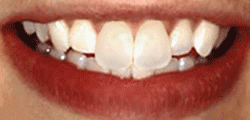
Bonding is a conservative way to repair slightly chipped, discolored, or crooked teeth. During dental bonding, a white filling is placed onto your tooth to improve its appearance. The filling "bonds" with your teeth, and because it comes in a variety of tooth-colored shades, it closely matches the appearance of your natural teeth.
Tooth bonding can also be used for teeth fillings instead of amalgam fillings. Many patients prefer bonding fillings because the white color is much less noticeable than the silver amalgam fillings. Bonding fillings can be used on front and back teeth depending on the location and extent of tooth decay.
Bonding is less expensive than other cosmetic treatments and usually can be completed in one visit to our office. However, bonding can stain and is easier to break than other cosmetic treatments such as porcelain veneers. If it does break or chip, tell your doctor. The bonding can generally be easily patched or repaired in one visit.
Bridges
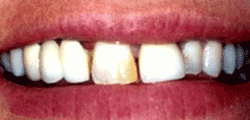
A bridge may be used to replace missing teeth, help maintain the shape of your face, and alleviate stress in your bite.
A bridge replaces missing teeth with artificial teeth, looks great, and literally bridges the gap where one or more teeth may have been. Your bridge can be made from gold, alloys, porcelain, or a combination of these materials and is bonded onto surrounding teeth for support.
The success of any bridge depends on its foundation – the other teeth, gums, or bone to which it is attached. Therefore, it's very important to keep your existing teeth, gums, and jaw healthy and strong.
Crowns
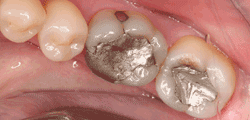
Crowns are a cosmetic restoration used to improve your tooth's shape or to strengthen a tooth. Crowns are most often used for teeth that are broken, worn, or have portions destroyed by tooth decay.
Crowns are "caps" cemented onto an existing tooth which fully cover the portion of your tooth above the gum line. In effect, the crown becomes your tooth's new outer surface. Crowns can be made of porcelain, metal, or both. Porcelain crowns are most often preferred because they mimic the translucency of natural teeth and are very strong.
Crowns are often preferable to silver amalgam fillings. Unlike fillings, which apply metal directly into your mouth, a crown is fabricated away from your mouth. Your crown is created in a lab from your unique tooth impression, which allows a dental laboratory technician to examine all aspects of your bite and jaw movements. Your crown is then sculpted just for you so that your bite and jaw movements function normally once the crown is placed.
Fillings
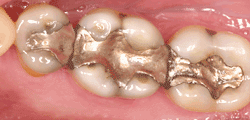
Traditional dental restoratives (fillings) include gold, porcelain, and composite/ amalgam. The strength and durability of traditional dental materials continue to make them useful for situations where restored teeth must withstand extreme forces that result from chewing, such as in the back of the mouth.
Newer dental fillings include ceramic and plastic compounds that mimic the appearance of natural teeth. These compounds, often called composite resins, are usually used on the front teeth where a natural appearance is important. They can be used on the back teeth as well, depending on the location and extent of the tooth decay. Composite resins are usually more costly than the older silver amalgam fillings.
What's Right for Me?
Several factors influence the performance, durability, longevity, and expense of dental restorations:
- The components used in the filling material
- The amount of tooth structure remaining
- Where and how the filling is placed
- The chewing load that the tooth will have to bear
- The length and number of visits needed to prepare and adjust the restored tooth
The ultimate decision about what to use is best determined in consultation with your doctor. Before your treatment begins, discuss the options with your doctor. To help you prepare for this discussion it is helpful to understand the two basic types of dental fillings: direct and indirect.
- Direct fillings are fillings placed immediately into a prepared cavity in a single visit. They include dental amalgam, glass ionomers, resin ionomers, and composite (resin) fillings. The dentist prepares the tooth, places the filling, and adjusts it during one appointment.
- Indirect fillings generally require two or more visits. They include inlays, onlays, veneers, crowns, and bridges fabricated with gold, base metal alloys, ceramics, or composites. During the first visit, the dentist prepares the tooth and makes an impression of the area to be restored. The dentist then places a temporary covering over the prepared tooth. The impression is sent to a dental laboratory, which creates the dental restoration. At the next appointment, the dentist cements the restoration into the prepared cavity and adjusts it as needed.
Implants
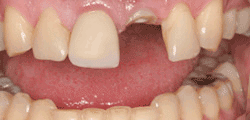
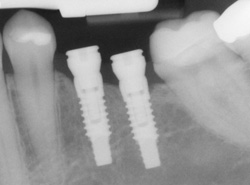
If you have missing teeth, it is crucial to replace them. Without all your teeth, chewing and eating can destabilize your bite and cause you discomfort. When teeth are missing, your mouth can shift and even cause your face to look older. Implants are a great way to replace your missing teeth.
An implant is a new tooth made of steel and porcelain that looks just like your natural tooth. Your implant is composed of two parts that mimic a tooth's root and crown. The implant's "root" is a titanium steel rod placed into the jaw bone to act as a root. Once the rod is in place, a porcelain crown is attached to replace the top part of your tooth.
Implants may also be used to anchor dentures, especially lower dentures that tend to shift when you talk or chew. Plus, for patients with removable partial dentures, implants can replace missing teeth so that you have a more natural-looking smile.
Teeth Whitening
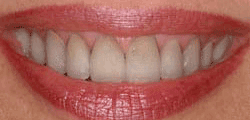
Everybody loves a bright white smile, and there are a variety of products and procedures available to help you improve the look of yours.
Many people are satisfied with the sparkle they get from brushing twice daily with fluoride toothpaste, flossing once a day, and regular cleanings at the dentist's office. However, if you decide you would like to go beyond regular care to make your smile look brighter, you should investigate all of your options.
Finding the Best Treatment for You
Schedule a visit with your dentist to learn whether whitening procedures would be effective for you. Whiteners do not correct all types of discoloration. For example, yellowish teeth will probably bleach well, brownish teeth may bleach less well, and grayish teeth may not bleach well at all. Likewise, whitening may not enhance your smile if you have had tooth-colored fillings or crowns. The whitener will not affect the color of these materials and they will stand out in your newly whitened smile. In these cases, you do have other options, such as porcelain veneers.
Tooth Whitening Treatments
- Professional teeth whitening with your doctor
- At-home whitening system
- Whitening toothpaste
Professional Teeth Whitening
Professional teeth whitening by your doctor is your best choice when you need immediate whitening results. This procedure is called chair-side bleaching and may require more than one office visit. Each visit may take from 60 to 90 minutes.
During chair-side bleaching, the dentist will apply either a protective gel to your gums or a rubber shield to protect the oral soft tissues. A bleaching agent is then applied to the teeth and a special light may be used to enhance the action of the agent.
At-Home Whitening System
There are several types of products available for use at home that can either be dispensed by your doctor or purchased over the counter. They are generally teeth whitening trays (mouthguards), strips, or paint-on products.
Teeth Whitening Trays
These products contain peroxide(s) which actually bleach the tooth enamel. Carbamide peroxide is the bleaching agent and comes in several different concentrations (10%, 16%, and 22%). Peroxide-containing whiteners typically come in a gel and are placed in a mouthguard. Usage regimens vary. Some products are used twice a day for 2 weeks, while others are intended for overnight use for 1-2 weeks. If you obtain the bleaching solution from your doctor's office, they can make a custom-fitted mouthguard for you that will fit your teeth precisely. Currently, only dentist-dispensed, home-use, 10% carbamide peroxide tray-applied gels carry the ADA Seal.
Teeth Whitening Strips
Teeth whitening strips are thin, flexible plastic (polyethylene) strips with a thin film of hydrogen peroxide bleaching on one side. Whitening strip kits come with two types of strips: strips for the upper teeth and strips for the lower teeth. The bleaching agent is applied by placing the strips across your teeth and gently pressing the strips into place to ensure contact with all your teeth. Teeth whitening strips are typically worn for 30 minutes a day, twice a day. The duration of treatment will vary.
Paint-On Teeth Whitening
Paint-on teeth whitening allows you to apply a bleaching agent directly to your teeth without an appliance or strip. You simply "paint" the whitener onto the surface of clean, dry teeth and wait about 30 minutes while the paint turns to a dry film. To remove this film, you simply brush your teeth with a toothbrush. Paint-on whitening products require twice-daily applications to be effective. The duration of treatment will vary. An advantage in this process is that you can selectively paint individual teeth.
Teeth whitening can have minor side effects and you should speak with your doctor if these become bothersome. For example, teeth can become sensitive during the period when you are using the bleaching solution. In most cases, this sensitivity is temporary and should lessen once the treatment is finished. Some people also experience soft tissue irritation, either from a tray that doesn't fit properly or from solution that may come in contact with the tissues. If you have concerns about such side effects, you should discuss them with the doctor.
Whitening Toothpaste
All toothpastes help remove surface stain from your teeth through the action of mild abrasives. "Whitening" toothpastes in the ADA Seal of Acceptance program have special chemical or polishing agents that provide additional stain removal effectiveness. Unlike bleaches, these ADA Accepted products do not alter the intrinsic color of teeth.
Veneers

There's no reason to put up with gaps in your teeth or with teeth that are stained, discolored, badly shaped, chipped, or crooked. Today, a veneer placed on top of your teeth can correct nature's mistake or the results of an injury and help you have a beautiful smile. Veneers are a highly popular solution among dental patients because of their life-like tooth appearance.
Veneers are thin, custom-made shells crafted of tooth-colored materials (such as porcelain) designed to cover the front side of your teeth. To prepare for veneers, your doctor will create a unique model of your teeth. This model is sent to the dental technician to create your veneers. Before placing your new veneer, your doctor will remove a small amount of your tooth to make room for the veneer.
When placed, you'll be pleased to see that veneers look like your natural teeth and even resist staining. Though veneers are stain resistant, your doctor may recommend that you avoid coffee, tea, red wine, and tobacco to maintain the beauty of your veneer.
